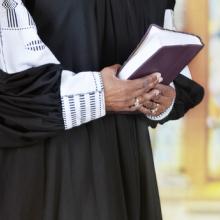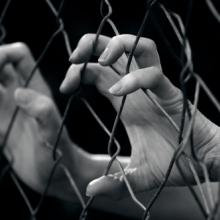gender justice
When I began my theological education, I encountered an even more disturbing reality: the presence of “texts of terror” as Hebrew scholar Phyllis Trible calls them. These heinous sexual crimes and acts of violence committed against women were captured right there, plain as day, in the holy book I treasured.

Image via Seth Drum/Flickr
The vast majority of incarcerated women have a history of trauma. According to the Court Services and Offender Supervision Agency, 75 percent of incarcerated women have suffered severe physical abuse by an intimate partner during adulthood, and 82 percent have endured serious physical or sexual abuse as children.
Their presence reminds communities globally that sexual violence is not just a women’s issue. It is a human rights issue, and we need our sons to stand with young women as the next generation works to heal the whole community. Our sons understand the struggles of growing up on social media and witnessing the privacy of others exploited with a single click. They grew up in schools that prepare for mass shootings. They understand things differently than we do, and we need them to help lead us now that they are in college and entering the workforce.
One afternoon I was invited to share my experiences as a woman in Christian leadership — the challenges, joys, issues, struggles and blessings. It felt like those of us sharing were instant, intimate, connected soul sisters. Without knowing each other, and as different as our stories were, the common threads ran deep. We were all women in high levels of leadership in Christian organizations. So why does it still hurt so much? We’ve made so much progress, haven’t we?
After some questions, we reviewed what we would each share from our different perspectives. This would be a heartfelt, sincere, and vulnerable time of sharing. But I wasn’t quite prepared for what happened. The opening question was, “When did you first experience a challenge or issue with your leadership as a woman?” As the first woman began her story, the vulnerable places of her past and present began to flow through tears streaming down her face. And my own eyes welled up and brimmed over. This struck home to the core of my own experience. This is hard. It hurts.
Here are just a few of the barriers we shared about that afternoon. There’s the way that women are looked at differently with respect to their leadership styles. What is seen as strength in a man’s style may be critiqued as aggressive in a woman. When a man’s ego affects his decision-making, rarely is it confronted or dealt with, whereas a woman is called out for letting her emotions get in the way. This feeds the fear for many women leaders that it’s not OK to display any vulnerability. As much as we don’t want to admit it, there is also still a bit of a “good ole boy” way of operating even in Christian organizations that are advocates of reconciliation. To call it out can get one the blame of having a “chip on one’s shoulder” and playing the gender card for personal gain.
“Mom,” I asked, “why didn’t the ERA pass?”
It was 1982 and I was 13 years old — an age with sharp awareness of what is fair, but with no understanding of the forces aligned to thwart history’s progress. I was unaware of the storm swirling around the Equal Rights Amendment. I was only aware of my mother’s belief that it should pass.
I wasn’t an evangelical, yet – or even a churchgoer. I was simply a girl standing at the precipice of womanhood in a household led by a strong woman who cranked up the car radio whenever Helen Reddy’s “I Am Woman” or Gloria Gaynor’s “I Will Survive” piped through station-wagon speakers.
We are woman! We are strong! We are invincible. We are survivors and we roar!
So, I had no idea that Phyllis Schlafly (a conservative Catholic) and a broad contingent of evangelicals were actively campaigning against the simple amendment that required ratification that year.
The ERA was intentionally simple. Like the 19th Amendment, the heart of the amendment was one sentence long: “Equality of rights under the law shall not be denied, abridged by the United States or by any state on account of sex.”
Seemed simple enough. It was fair. Anything less would be unfair. So how could anyone stand against it?
I firmly believe that people of faith can transform the world. Despite the many flaws and failures of the church and her people, Christians have a tremendous amount of power and influence to do good. This campaign is all about harnessing the leadership of churches and clergy, and encouraging people of faith to raise their voices on behalf of women and girls. Through education and empowerment, we can confront gender-based oppressions and change harmful practices, policies, and structures within the church and the broader culture. It’s a tall order, but one that demands nothing less from us if we truly believe in the sacred worth of women and girls.
Women of faith have moved hearts, minds, and mountains. They have changed the world by their faithful witness – and changed lives. Through our Women and Girls campaign, Sojourners is working to gather and lift up the voices and stories of these women to inspire a new generation of women to lead on faith and justice.
Sojourners’ Women and Girls campaign is our newest initiative in our ever-expanding work for justice in our world. Through creative advocacy, education, outreach, bridge-building, and a variety of other ways, we are affirming and empowering the God-given leadership abilities of women and girls in their congregations, communities, and the world.
To celebrate Women’s History Month, we asked some of our supporters to make a gift in honor of a woman of faith in their life. Below are the stories of a few of these women of faith.
You can certainly get community outside of church, says bestselling author and blogger Rachel Held Evans, but that doesn’t mean it’s not worth being part of a church community.
“Church forces us into relationship with those who are different than us,” Rachel told Sojourners. As a follower of Christ, she said, I have to be ready and willing to be in community with those who are different than me.
I recently caught up with Evans at Eastern Mennonite University in Harrisonburg, Va. It was her ninth public appearance in the eight weeks as she bounced from Texas and the Midwest to the East Coast and back to Texas, with a foray to Michigan.
Rachel has made her career out of vocalizing what others are feeling, but can’t articulate quite as clearly.
One of the most commonly sexted biblical texts comes from the 5th Chapter of Matthew’s Gospel, when we hear the following words attributed to Jesus: “You have heard that it was said, ‘You shall not commit adultery.' But I tell you that anyone who looks at a woman lustfully has already committed adultery with her in his heart” (5:27-28). At first glance the biblical text appears quite straightforward, as Jesus is speaking to a small group of men, and it seems that he simply proclaims the need to keep their sexual temptations in check. “Fellas, keep it in your pants and out of your minds, or else!” is a standard religious reading. However, such an overtly sexted interpretation of the biblical text limits the extensiveness of what Jesus actually attempted to communicate through it. In other words, the text in question is about far more than physical sex, as it serves Jesus’ much larger liberative purpose to strategically and radically revolutionize the totality of how women and men related to each other.
Eight years ago I left my dorm room, humming the hook to “Till I Collapse” on my walk to the bathroom. When I returned a new song was playing on my laptop. Ludacris’ “P-Poppin’” pierced through the thin walls and echoed down the hallway. I bobbed my head along and then sat down to finish my homework. I looked at the screen, and I thought I saw my sister.
One of the women on the screen in the strip club swinging around a pole trying to seduce Ludacris looked like Jennifer – my older sister.
And something began to shift.
Two things are clear in both creation stories: 1) both men and women are created to exercise equal dominion, and 2) according to Genesis 1:31, this relationship between men and women was “very good.” This is what right relationship between men and women looks like. It is only after the fall of humanity — when we decided not to trust God’s ways, when we decided to grab at our own way to peace and gratification — that women were subjected to men. And I see nothing in the text that says this is the way God wanted it. Rather, I see this is the natural result of choosing to exercise a human kind of dominion rather than one that reflects the image of God. Humanity grabs at its own peace at the expense of the peace of all.
Good news: the Violence Against Women Act passed the Senate this afternoon. While the bill still must proceed to the House of Representatives, this is a promising step for women across the country.
VAWA provides much-needed services and protections for women, which should not be a controversial issue. However, the bill expired in 2011 and has yet to be reauthorized, with most of the delay coming from a debate over whether the protections can extend to Native American women living on reservations.
A recent story shows the importance of extending these protections to Native woman: the woman profiled was attacked by her (white) husband, but neither the tribal court nor the local police felt they had proper authority to protect her.
This is not an isolated incident: during the Senate hearing on the bill, Sen. Maria Cantwell (D - Wash.) pointed out that Native American women are raped and assaulted at 2.5 times the national rate, and fewer than 50 percent of domestic violence cases on reservations are prosecuted.





![Dorothy Day, By Unknown photographer [Public domain], via Wikimedia Commons By Unknown photographer [Public domain], via Wikimedia Commons](https://sojo.net/sites/default/files/styles/medium_square/public/blog/Dorothy_Day_1916.jpg?itok=PSCf7hgy)




